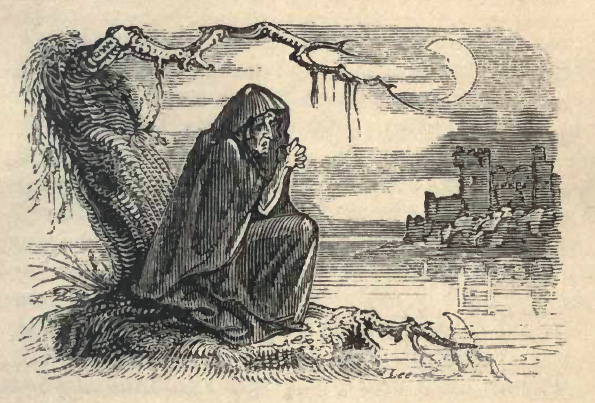The Banshee
An Irish malevolent female, Faerie is often connected to a family even though she lives in the woods, bog, or forest. They are known to scream like a howling wind or a screeching of an owl plummeting to its prey when a family member’s death is imminent and will continue onwards long after the death in mourning. This is where the common phrase “scream like a banshee” comes from. Some blame the Keener women who wail in mourning at funerals and gave birth to the legend of the banshee.
They seem to be attached to families that have the Ó or Mac prefix. They harbor omens of death and messages from the underworld. Their main purpose is to warn of death by beginning to wail if someone is about to die. Some say they only warn if someone is about to die in a violent means such as a tragic accident, murder, or catastrophe.
They are not always seen, mostly heard, especially at night. Some claim the island winds that Ireland, Scotland, and England experience howling through the windows, shutters, or glass panes sound like a banshee and are the root of the noise. I can attest every windy night I’ve spent in Ireland, I’ve heard what I imagine to be the wail of the banshee. In fact, as I write this, the wind is making such noises coming through the windows and woodwork. Another logical explanation is that of the owl – Screech Owls have a similar sound to that of banshees and, during their nocturnal hunts, are known for their chilling screech.
However, there are those who claim to have seen them, and when they do, they often appear as an ugly, scary-looking hag or old woman. Others claim they shape-shift and, while they can appear as an old hag, can also appear as a young, beautiful woman. In addition to appearing as an old hag, they have been described as wearing grey or white gowns with long pale hair that they brush with a silver comb, though this could come from mixing them up with mermaids, says scholar Patricia Lysaght. Some Celtic lore suggests that banshees originated from the death of a washwoman who died in childbirth, and this is why banshees are often seen washing or preening next to pools or fjords in the forest or along the banks of a spring or river. Though this could be a confusion of them with naiads.

They are sometimes described as having winds and being in flight, while other legends confine them to walking the land in the dark of night. Some say they’ve been blended by monks’ descriptions of them with Lilith. Lilith is often depicted as a voluptuous female with feather-like hair, wings, and owl-like feet perched atop two male lions binding them together by their waists. Some legends claim the manifestation of a banshee at first would transform into the Irish battle Goddess known as the Morrigan. She has also appeared in anamorphic forms such as a stoat, hare, hooded crow, or weasel.
There are counterparts of the Banshee throughout the Western world, such as in Scotland as the “bean with” or “bean-night,” which is often seen washing blood-stained armor or clothes of those about to die. Reports of sightings of bean sith and banshees were abundant even in recent times. They are also found in Welsh mythology, Norse mythology, and American folklore.
A report from King James I of Scotland in 1437 claimed he was approached by an Irish seer who was later identified as a banshee.
She foretold of his murder at the instigation of the Earl of Atholl. Irish history and mythology tell tales of many prophets who were believed to be banshees who advised the local courts of Irish Kings and the great houses of Ireland. On Rathlin Island, legend describes the banshee’s cry as a “thin screeching sound somewhere between the wail of a woman and the moan of an owl.” In Leinster, there are tales of the “bean chaointe” whose wail is so piercing that it shatters glass. In Kerry, tales report the scream as a low, pleasant singing of a song. Tyrone reports the sound resembling two boards being struck together. They have been said to have cried during the death of Brian Boru. 18th century C.E. American folklore talks about banshee tales in Tar River, North Carolina, though it could be the report of a ghoul that was mislabeled a banshee. In South Dakota, a banshee is said to wail upon a hill near Watch Dog Butte. None of the American legends associate the wail with an oracle of death.
Bibliography / Recommended Reading:
- Croker, Thomas Crofton undated “Fairy Legends and Traditions”. Website referenced on 12/23/13 at http://books.google.ie/books?id=3jCPRo9GAE8C&pg=PT133&lpg=PT133&dq=Gougane+Barra+fairy&source=bl&ots=zVDgcqoGvM&sig=EGQByEFSCrbPtok_RMVoMgdye7s&hl=en&sa=X&ei=VBG4UuJRqaztBt6bgOgC&ved=0CIIBEOgBMAs#v=onepage&q=Gougane%20Barra%20fairy&f=false. Library of Alexandria: unknown.
- Croker, Thomas Crofton undated “Fairy Legends and Traditions of the south of Ireland”. Website referenced on 12/23/13 at http://books.google.ie/books?id=ltoDAAAAQAAJ&pg=PA274&lpg=PA274&dq=Gougane+Barra+fairy&source=bl&ots=y2RVZLcpEv&sig=0VH_Ip4ZQp_uexpefGt3yHAMPuQ&hl=en&sa=X&ei=VBG4UuJRqaztBt6bgOgC&ved=0CIUBEOgBMAw#v=onepage&q=Gougane%20Barra%20fairy&f=false
- Mental Floss undated “10 Legendary Monsters of Europe”. Website referenced on 12/26/13 at http://mentalfloss.com/article/12685/10-legendary-monsters-europe.
- Mercian Gathering undated “Bad Faeries” website referenced 12/24/2013 at http://www.merciangathering.com/bad_fairies.htm.
- Wikipedia: The Free Encyclopedia undated “Banshee”. Website referenced on 12/26/13 at http://en.wikipedia.org/wiki/Banshee.